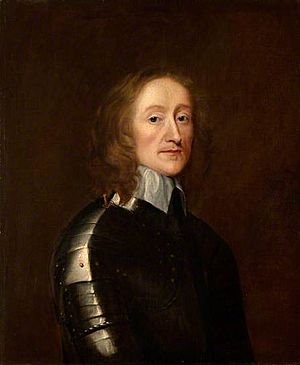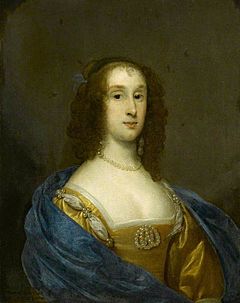Charles Fleetwood facts for kids
Quick facts for kids
Charles Fleetwood
|
|
|---|---|

Portrait by Robert Walker
|
|
| Commander-in-Chief & Committee of Safety | |
| In office June 1659 – December 1659 |
|
| Lord Deputy of Ireland | |
| In office September 1652 – July 1657 |
|
| English Council of State | |
| In office February 1651 – July 1652 |
|
| Member of Parliament for Marlborough |
|
| In office May 1646 – January 1655 (reseated May 1659) |
|
| Personal details | |
| Born |
Fleetwood
c. 1618 Aldwinkle, Northamptonshire, England |
| Died | 4 October 1692 (aged 74) Stoke Newington, London, England |
| Resting place | Bunhill Fields |
| Spouses | (1) Frances Smith (1641–1651) (2) Bridget Cromwell (1652–1662) (3) Mary Coke (1663–1684) |
| Children | (1) Frances (1642–1711); Smith (1644–1708) (2) Cromwell (1653–1688); Ann (1654–1660); Mary (1656–1722) |
| Alma mater | Emmanuel College, Cambridge |
| Occupation | Soldier and politician |
| Military service | |
| Rank | Major General |
| Battles/wars | |
Charles Fleetwood (born around 1618, died October 4, 1692) was an important English lawyer and soldier. He fought for the Parliamentarian army during the Wars of the Three Kingdoms, also known as the English Civil War. Fleetwood was a close friend and family member of Oliver Cromwell, a very powerful leader at the time.
After the war, Fleetwood held many high-ranking jobs in the government, including being in charge of Ireland. When Oliver Cromwell died, Fleetwood played a big part in the political changes that followed. He eventually had to leave public life but lived a quiet life until his death.
Contents
Who Was Charles Fleetwood?
Charles Fleetwood was born around 1618 in Aldwinkle, Northamptonshire, England. He was the third son of Sir Miles Fleetwood. He likely studied at Emmanuel College, Cambridge, and later became a lawyer.
Joining the English Civil War
When the First English Civil War began in 1642, Charles Fleetwood joined the Parliamentarian army. Many young lawyers like him became important soldiers. He was hurt at the First Battle of Newbury in 1643.
By 1644, he was leading his own group of soldiers. He fought in major battles like Battle of Naseby. He also became a member of parliament for Marlborough.
Fleetwood's Role in Parliament and Army
Fleetwood was a key figure in the disagreements between the army and the Parliament. He was thought to be a main planner in the idea to capture King Charles I of England. However, he did not take part in the king's trial.
In 1649, he became a governor of the Isle of Wight. The next year, he joined Oliver Cromwell's army in Scotland. He helped win the important Battle of Dunbar.
In 1651, he became a member of the Council of State. He was put in charge of the forces in England. He played a major part in the final victory at the Battle of Worcester in September 1651.
Leading in Ireland
In 1652, Charles Fleetwood married Bridget Cromwell. She was Oliver Cromwell's daughter and the widow of Henry Ireton. After this marriage, Fleetwood became the commander of the Parliamentarian forces in Ireland. He was also given the title of Lord Deputy of Ireland. This meant he was the main leader in Ireland.
Ending Resistance in Ireland
During his first year in Ireland, Fleetwood worked to end the last of the Irish resistance. He talked with the remaining groups of fighters. He offered them a choice: surrender or leave the country to join other armies. The last organized Irish force gave up in 1653.
New Land Rules
From 1652 to 1655, Fleetwood oversaw new land rules in Ireland. These rules were part of the Act of Settlement 1652. This act gave land that was taken from Catholic landowners to the soldiers of the New Model Army. The original owners were forced to move to other areas. Fleetwood carried out these policies very strictly.
He also treated Catholic priests harshly. He favored certain Protestant groups, which caused a lot of unhappiness. People eventually asked for him to be called back to England.
Working for the Protectorate
Charles Fleetwood was a strong supporter of Oliver Cromwell's plans. He agreed when Cromwell became Lord Protector. He also supported Cromwell when he dismissed parliaments.
In 1654, Fleetwood became a member of Cromwell's council. After returning to England in 1655, he was made one of the main generals. He agreed with most of Cromwell's new government ideas. He only disagreed with Cromwell becoming "king."
He became a member of the new House of Lords. He strongly supported Cromwell's foreign policy, which aimed to protect Protestants in other countries. Because of his loyalty, some thought Cromwell might choose him as his successor.
After Cromwell's Death
When Oliver Cromwell died in September 1658, Fleetwood was seen as a possible new leader. However, he supported Cromwell's son, Richard Cromwell, becoming the new Lord Protector. But soon, Fleetwood and other army officers pushed Richard to give up his power in April 1659.
Fleetwood, along with John Lambert, then had a lot of control over the government for about a year. But their power was eventually taken by George Monck.
The End of the Protectorate and Return of the Monarchy
After Parliament was shut down, Fleetwood and Lambert's group, the Committee of Safety, was in charge. But they didn't have much public support. Many people were unhappy, and the soldiers weren't getting paid.
Several Parliamentarian generals, led by George Monck, decided that the only way to bring stability back was to bring back the monarchy. Monck marched his troops from Scotland towards London.
As Monck's army approached, Fleetwood stayed in London and tried to keep order. While he was trying to decide which side to join, Monck's army brought back the Parliament on December 24. Fleetwood lost his command and was told to explain his actions to Parliament.
This led to the return of the monarchy, known as the English Restoration. Charles Fleetwood was not allowed to hold any public office again. He lived quietly in Stoke Newington, a village north of London at the time. He died there on October 4, 1692. He was buried in Bunhill Fields.
Legacy and Family Connections
In 1664, Charles Fleetwood married Mary Coke. Through this marriage, he gained an estate in Stoke Newington. A house there, Fleetwood House, was named after him. This house became a meeting place for English Dissenters, who were Protestants who disagreed with the Church of England. Later, it became a school for girls.
A water-colour painter named Cornelius Varley believed his family was related to both Fleetwood and Cromwell. He named his son Cromwell Fleetwood "C.F." Varley (1828–1883) because of this belief.
Images for kids




